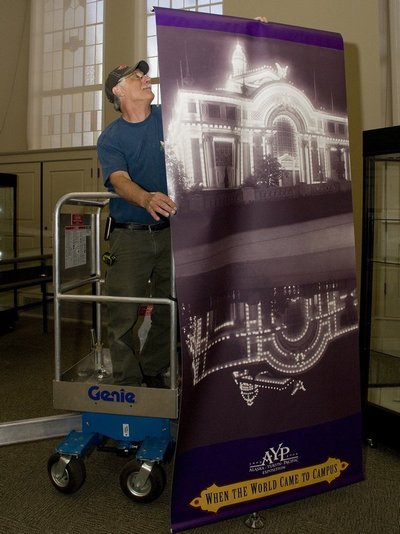May 28, 2009
Three AYPE exhibits open June 1 at Suzzallo/Allen Library
When Carla Rickerson was the Pacific Northwest librarian at the UW 25 years ago, she created an exhibit on the Alaska-Yukon-Pacific Exposition to commemorate its 75th anniversary. Now that the exposition has reached its centennial, Rickerson — now the Head of Public Services in the UW Libraries’ Special Collections — finds herself creating another exhibit, and coordinating two others that will be housed in Suzzallo/Allen Libraries this summer.
The Alaska-Yukon-Pacific Exposition: When the World Came to Campus will be in the Suzzallo Exhibit Room, 102, Women’s Work at the 1909 Alaska-Yukon-Pacific Exposition in the lobby outside Special Collections in the south Allen basement and Capturing the Alaska-Yukon-Pacific Exposition: Frank H. Nowell, Exposition Photographer in the balcony above the north Allen lobby. All three will open June 1.
When the World Came to Campus will be a comprehensive exhibit covering all of the AYPE, from its origins as an idea to promote Seattle through the transformation of the undeveloped campus into a fairgrounds and the legacy it left behind for the University.
“One of the things we thought was interesting was that people were encouraged to come and visit the buildings while they were going up,” Rickerson said. “So we have a letter from the manuscript collection inviting people to come and see how their money was spent. Some of the exposition was financed publicly by the people of Seattle.”
Most of the exhibit will consist of photographs and various kinds of paper memorabilia. Special Collections, Rickerson explains, has hundreds of photos by official AYPE photographer Frank Nowell. In fact, the Allen balcony exhibit is devoted to Nowell and his work. But Rickerson is also using between 200 and 250 of the photos in the exhibit in the Suzzallo Exhibit Room. Some of the photos will be blown up very large and posted on the walls, while others will be displayed in the room’s glass cases.
The papers on display will include newspaper clippings, tickets, post cards, manuscripts of speeches and so forth. “The library has the actual manuscript James Hill was holding in his hands when he gave a speech on opening day of the exposition,” Rickerson said. (James Hill was a railroad tycoon who helped fund the exposition. His statue is on Stevens Way near More Hall.)
There’s also correspondence from the papers of Edmond Meany, a UW professor at the time who was influential in bringing the AYPE to campus, and items from the Board of Regents’ records about the board’s interactions with the architect. Nonpaper items include buttons, commemorative plates and cups, many on loan from the Museum of History and Industry.
In 102, Rickerson has twice as much space as she did for the 75th anniversary exhibit, and she hopes to give visitors a view of what life was like in 1909 Seattle and what people experienced when they came to the AYPE. Thanks to funds from the Friends of the Libraries and the Provost’s Office, she was able to hire an exhibit designer, as well as a librarian to help her with the research for the exhibit, but in a way, she’s been studying the AYPE ever since her adventure on the 75th anniversary.
“Back then I was asked to give a presentation on the AYPE. So with the help of one of my colleagues in Special Collections, we took hundreds of slides of the materials that we have and I put together a talk,” Rickerson said.” I gave that presentation several times, and of course as I was doing that I was researching it and learning more about it. And over the years I’ve continued to be interested and have read more on it. In Special Collections I have access to a lot of really wonderful primary source material as well as secondary.”
Rickerson has given her presentation several times during this centennial year, but none of those presentations has been at the University.
Michelle Dent, a visiting curator from New York University, is zeroing in on one aspect of the AYPE for her exhibit next to Special Collections. She’ll be looking at the role of women at the exposition.
“My dissertation research was about the history of world fairs, and world fairs were sites for professionalization for women,” Dent said. “They were places where women converged and convened for conferences, for leisure and also for work, whether it was conferencing around issues of suffrage or temperance or coming to the fairs to be fair workers.”
The Special Collections exhibit will focus particularly on the iconography of women and will feature “some beautiful materials being loaned to us by the Burke,” Dent said. These ethnological objects come from one of the Alaska Building Collections curated in 1909 by Mary Hart, one of the women featured in Dent’s exhibit.
The third exhibit, on the Allen balcony, is about Frank Nowell, and features material about his life and his photos — not only of the AYPE, but of his work in Alaska. Later this summer, the UW Press will publish a book about Nowell’s photographs by Nicolette Bromberg, visual materials curator in Special Collections, who co-curated the exhibit with Rickerson.
The exhibits, except for the Nowell exhibit, will be up until Oct. 30, which is longer than library exhibits usually run, Rickerson said. (The Nowell exhibit will be taken out in August but return for October and November.)
“We want to really show the excitement of the AYPE and what a cool thing it was,” she said. “It’s incredible that they took what was basically 250 acres of wilderness and turned it into this beautiful vision.”



